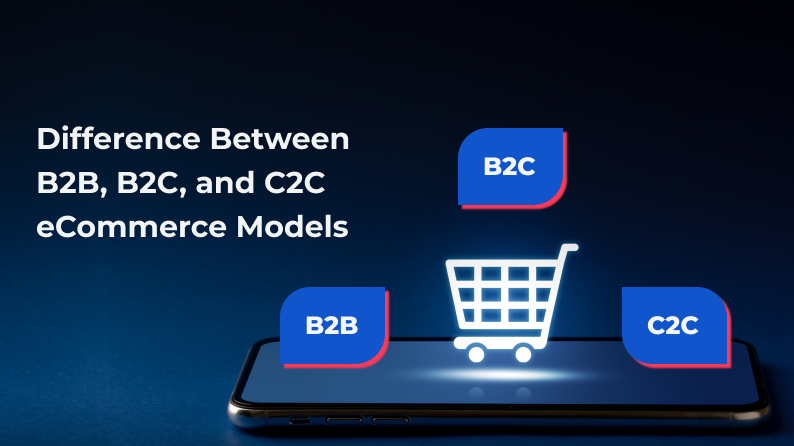eCommerce is an undeniable trend that has been reshaping the way customers shop. According to market research, eCommerce made up 14.7% of retail sales in the U.S. in 2022 and it is expected that by 2025, it will make up nearly 22% of the total purchases in the country. Hence, it is pivotal to understand the types of business models if you are trying to set a foot in the eCommerce world.
In this write-up, we cover eCommerce business models, B2B, B2C, and C2C, and how they differ from each other in meeting business expectations.
- 1. B2B (Business-to-Business) Model
2. B2C (Business-to-Consumer) eCommerce Marketplaces
3. C2C (Customer-to-Customer) eCommerce Model
- 1. Amazon
2. Epson America
Major eCommerce Marketplaces Models: B2B, B2C, and C2C
Before starting your eCommerce business, you need to carefully consider the different eCommerce business models possible to determine the best fit for your specific needs and goals. Below we discuss the three major eCommerce models.
Also, we have included key features that are needed in a marketplace to facilitate smooth operations of these business models.
B2B (Business-to-Business) Model
The business-to-business eCommerce marketplace facilitates a business to sell its goods or services to another business. It mainly involves commercial transactions between manufacturers, wholesalers, retailers, and distributors that need goods in bulk.
Examples of B2B eCommerce marketplaces include Alibaba, Global Sources, and ThomasNet.
Explore the post on Building B2B Online Marketplace
Key Marketplace Features That Make B2B eCommerce Model Work
– Minimum Order Quantity: In B2B eCommerce marketplaces, sellers focus on providing bulk orders and special discounts for businesses that place large orders. No buyer can request an order below MOQ.
– Quote Management: B2B eCommerce marketplaces often offer access to RFQ requests or view re-quoted offers, speeding up the quoting procedure.
– Search and Filtering Capabilities: Buyers can search for goods or services using keywords, categories, and filters to find what they are looking for.
– Shipping Management: Pre-integrated third-party shipping APIs that allow quick creation of shipping labels and real-time shipment tracking.
– Digital Payment Methods: It supports a mix and wide range of payment methods to offer an appreciable checkout experience.
Build a B2B marketplace with result-oriented B2B features
B2C (Business-to-Consumer) eCommerce Marketplaces
Using this model, businesses sell their products or services directly to end-consumers. The marketplaces built on the B2C model have a short buying journey. The end-consumers know their needs, they browse options, and place their order. Moreover, a B2C digital marketplace bridges the gap between physical spaces and offers personalized eCommerce experiences.
Examples of B2C eCommerce marketplaces are Amazon and Walmart.
Key Features That Make B2C eCommerce Model Work
– Inventory Management: B2C marketplaces offer tools to keep a check on stock levels and handle sales accordingly.
– Intuitive User Panels: B2C marketplace has dedicated user panels for sellers, buyers, and admins, enabling all to easily access account details such as insights, key statistics, and more.
– Standardized Pricing: The price of the product is the same for everyone, regardless of their purchase history or volume of previous orders.
– Product Catalog: A product/service listing feature is provided to the vendors to upload product details including specifications, description, quantity, media, and so on.
– Platform Management: There can be multiple features that allow marketplace admin to control and manage various eCommerce operations in a marketplace.
Explore An In-depth Guide to Build a B2B2C Marketplace
C2C (Customer-to-Customer) eCommerce Model
The Customer-to-Customer business model represents a marketplace that allows one customer to sell their goods or services to another customer directly. The focus is usually on selling used or unique products not readily available in retail stores. The customers can put a product on sale and other customers can browse and decide from the goods/services posted that they are interested in buying.
Examples include OLX, Etsy, and Quikr.
Key Features That Make C2C eCommerce Model Work
– Commission-Based Revenue Model: C2C eCommerce marketplace platforms usually charge a commission on the transactions that place orders on their platform. The commission can be a percentage of the sales price, a flat fee per transaction, or a combination of both.
– Platform Management: It comprises extensive features for admin like managing seller and buyer accounts and payment processing for better C2C platform management.
– Advanced Filters and Search Capability: It enables buyers to execute their search for a specific product based on pricing and feature preferences.
– Reviews and Rating System: C2C marketplaces feature customer reviews and ratings of sellers and products, which help buyers make informed decisions.
– Product Listings: Sellers can list items for sale, including descriptions, photos, and pricing information.
How to build C2C marketplace – read this post
Examples of Businesses That Use Multiple Models to Diversify Their Revenue Streams
Below is the name of a few businesses that use multiple business models to diversify their revenue streams and increase their chances of growth in the long run.
Amazon
Amazon is a marketplace that connects customers with multiple sellers of all sizes, including small businesses. The platform is constantly innovating and introducing new products and services to its customers.
According to eMarketer, the net sales of Amazon jumped 15%, from $110.8 billion to $127.1 billion in 2022, and are projected to grow by $746 billion by the year 2023. The reason behind such diversification in their sales is Amazon acts both as a B2C and a C2C marketplace. It is a two-sided online platform where both Amazon and third parties sell goods from multiple categories. It includes apparel, accessories, electronics, B2B products, home decor, and so on. Amazon’s own services include Amazon Prime, Amazon Kindle, and so on.
Launch a marketplace with support for multiple revenue channels
Epson America
Epson America sells a wide range of products, including printed products for home offices. It supplies printing supplies for industrial use as well, including professional imaging machines, projectors, and robots. As a result, their website caters to both B2B and B2C customers by segmenting the customers and product types.
Also, it has an extensive search capability, allowing the customers to find the ideal product by entering the name, code, or model type.
Launch an eCommerce Marketplace With a Ready-Made Solution: Yo!Kart
Choosing Yo!Kart can help in accomplishing prolific growth. It is a multi-vendor eCommerce marketplace software with all the out-of-the-box functionalities to deliver future-ready platforms. It also provides multi-channel support to diversify eCommerce marketplace revenue streams through commissions, subscription packages, paid ads, PPC, and more.
The platform includes essential marketplace features for efficient business management and marketing by the admin, easy vendor selling, enabling an intuitive eCommerce experience for buyers. The software is scalable and pre-integrated with multiple business APIs and payment gateways like ShipStation, StripeConnect, and others.
In addition to Yo!Kart, there is another specialized solution known as Yo!Kart B2B, exclusively designed to power a marketplace for B2B eCommerce. It includes specific B2B functionalities like an in-built RFQ module, support for bundled and exclusive services and products, minimum order quantity, bulk price discounts, direct messaging, and more.
Core Features of Yo!Kart eCommerce Marketplace Platform
– Separate user panels for sellers, admin, and buyers
– Abandoned Cart Management
– Advanced Analytics and Reporting
– Intuitive Product Catalog System
– Multilingual Functionality
– Shipping Management
– Tested scalability and easy customization
Conclusion
Modern eCommerce marketplaces need to purpose-drive their underpinnings to streamline workflows for all platform participants, especially prioritizing customers’ online shopping journey, ranging from browsing and purchasing to returning or exchanging products.
Thus, identifying the right business model from the start, and the requisite features to effectively implement it – can produce favorable outcomes. Hence, knowing B2B, B2C, and C2C marketplace models and what they have to offer for varying business needs, make decision-making effortless.



